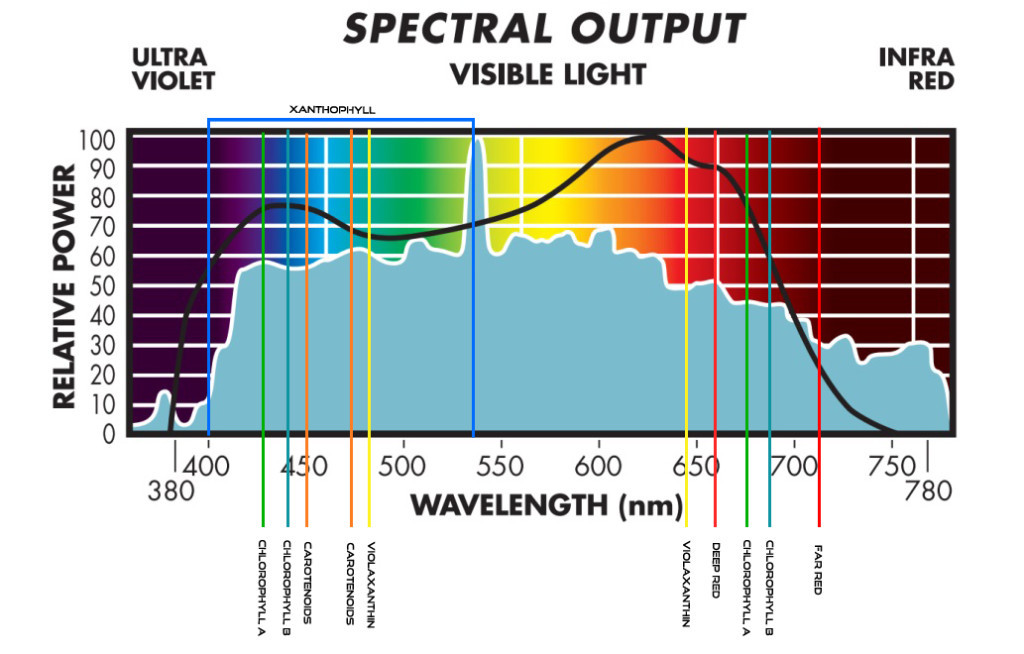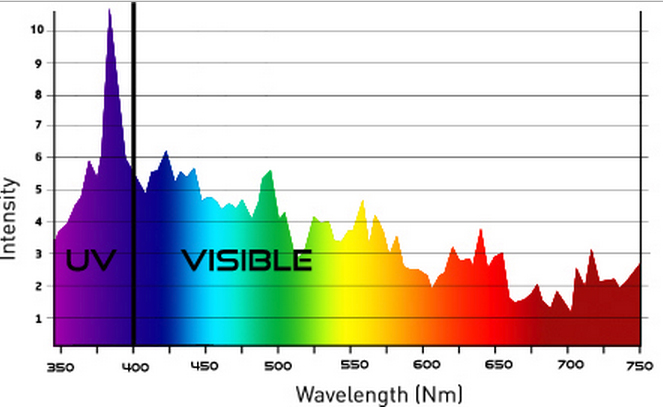
Light Spectrum and Usablitly
Plants use light for several purposes, including the regulation of life processes such as the initiation of flowering. But the most amazing thing that they do with light is photosynthesis, the process that provides the foundation for most of life on Earth. Plants use photosynthesis to power the process of making sugar (C6H12O6) from water (H2O) and carbon dioxide (CO2). Plants also use it to convert the sugars they make into starches and then into complex molecules such as cellulose. Add some nitrogen atoms, and you get nucleic acids and amino acids, the building blocks of all proteins.
Plants draw the energy they need from light across a spectrum broader than the human eye can see, from 400 nm (blue light) to 730 nm (red). Plants do different things with different wavelengths of light. Understanding the differences can help the careful cultivator ensure that the plants are getting everything they need to thrive.
For photosynthesis, light energy is captured by chlorophyll A and B primarily from the red and blue portion of the spectrums. Light absorption by chlorophyll A peaks at 430 nm in the blue band and 662nm in the red, and chlorophyll B peaks at 453 nm in the blue and 642 nm in the orange-red bands. Chlorophyll synthesis peaks at 435 nm and 445 nm in the blue spectrum and 640 and 675 nm in the red wavelengths.
Chlorophyll is not the only light-sensitive part of the plant. Carotenoids, are a group of orange pigments that capture light in the blue portion of the spectrum, primarily at about 450 nm in the blue spectrum and 475 nm in the blue-green range. Carotenoids not only contribute to photosynthesis but also protect the chlorophyll from excess light that could have destructive effects.
Anthocyanin and other flavinoid pigments also absorb blue and UV light to protect chlorophyll from photo-destruction.
Another pigment that appears to play a role in plant health is xanthophyll. This yellow pigment captures light in the range from 400-530 nm, but is usually hidden from our view by the green of chlorophyll. If a leaf loses its chlorophyll—because of a nitrogen deficiency, for instance….xanthophyll’s bright yellow color becomes apparent. Xanthophyll has several functions. First, it acts as a light and heat regulator. At dawn, it is in its low-energy form, violaxanthin, which has peak reactions to light at 480 nm and 648 nm. As the light increases to levels that might hurt the thylakoids and lead to photo-oxidation of the chlorophyll.
UVB LIGHT
Ultra-violet B light is a spectrum of light that is invisible to us but is visible to insects and some other organisms. In humans it causes suntan and sunburn and is implicated in the formation of eye cataracts. It is the light emitted by tanning bulbs.
UV-B importance – in areas of high ultraviolet radiation exposure, the UV-B (280-315 nm) absorption properties of THC may have conferred an evolutionary advantage to Cannabis capable of greater production of this compound from biogenetic precursor CBD. The extent to which this production is also influenced by environmental UV-B induced stress has been experimentally determined by Lydon et al. (1987). Their experiments demonstrate that under conditions of high UV-B exposure, drug-type Cannabis produces significantly greater quantities of THC.
UVB light also affects marijuana potency. The potency of high quality marijuana increases in direct ratio to the amount of UVB light it receives. This is very significant. In California, where the medical dispensaries operate in an unrestricted market; many dispensaries reject fall harvested outdoor material as inferior. They have found it lacks the potency of indoor crops and is a harsh smoke. However, when they were presented with marijuana grown outdoors but forced to ripen August 10, they accepted it as if it were indoor because of its high potency and lack of harshness. I think the harshness results from cool nights.
Adding UV-B light to your garden will enhance your marijuana naturally, without “special formulas” and chemicals. The Solis-Tek 10K bulb emits a tremendous amount of UVB and measured with a specific UVB meter, the SolarMeter 6.2, it has with more PAR ususable light in the red spectrum than even a Hortilux Super HPS. The Solis-Tek 10K greatly surpasses any other light we tested including Hortilux blue when used for finishing of your precious flowers.
These are the newest in horticulture lighting specifically designed for electronic ballasts and us the indoor horticulturist! We choose the following 2 bulbs for their exceptional usable spectrum SunMaster Full Nova & Solis-Tek 10K – Based on the available plant science of photosynthesis which are the spectral needs a.k.a. color needs a.k.a. nano-meter (nm) needs of light for our precious plant. Using this information we decided to give them a try and we are pleased we have changed over!
SunMaster Full Nova – Used for the Entire Grow & most of the flower cycle. We like how the Sunmaster Super Nova tops the charts with its usable blue and red, in comparison with other brands highly unusable greens and yellows, while having less than 20% usable spectrum.
Solis-Tek 10K – Last but definitely not least, we save the last 3 Weeks of flower finishing for this very unique Solis-Tek 10K with low iron glass (meaning more UVB for your Trichs!) bulb with unmatched UVB spectrum, which we measured with a SolarMeter Model 6.2 UV Meter by SolarMeter.com. Solis-Tek had the highest UVB rating among all the major brands we tested. They are the only manufacturers to date that are using low iron glass – UV increase to the max!
These 2 different manufactures have their place in our garden and they should be in yours! We used to be branded (brainwashed) by the other brands out there, until we wanted more! We wanted to educate ourselves to the fullest on what our plants needed for light. Take you time and enjoy the reading. It is up to us as the consumer to make informed educated decisions.
Below is a comprehensive list of photosynthesis measured at nano-meters
- Chlorophyll A peaks at 430 nm blue and 662nm red
- Chlorophyll B peaks at 453 nm blue and 642nm red
- Chlorophyll synthesis peaks 435 nm and 445 nm blue and 640 and 675 nm red
- Carotenoids primarily at about 450 nm in the blue and 475 nm in the blue-green range
- Xanthophyll – 400-530 nm
- Violaxanthin – 480 nm and 648 nm
- UVB 280nm -315nm
- UVA 315nm -380nm
- 660 nm Deep Red: Best for Night Interruption
- 730 nm Far Red: Promotes Flowering of Short-Day Plants (Not Photosynthetically Active)
SunMaster Full Nova has the highest in the absorbed peaks in blue and red
USABILITY IS KEY, NOT A GIANT SPIKE OF UNUSABLE LIGHT LIKE THE OTHER COMPANIES SHOW OFF

Solis-Tek 10K has the highest UVB output than any bulb on the market! This kick ass bulb also still has more usable reds than Hortilux Super HPS and more usable blue than Ushio!
USABILITY IS KEY, NOT A GIANT SPIKE OF UNUSABLE LIGHT LIKE THE OTHER COMPANIES SHOW OFF
 “Never argue with an idiot, they will lower you to their level and beat you by experience!” – Joe Fresh – ICMAG
“Never argue with an idiot, they will lower you to their level and beat you by experience!” – Joe Fresh – ICMAG